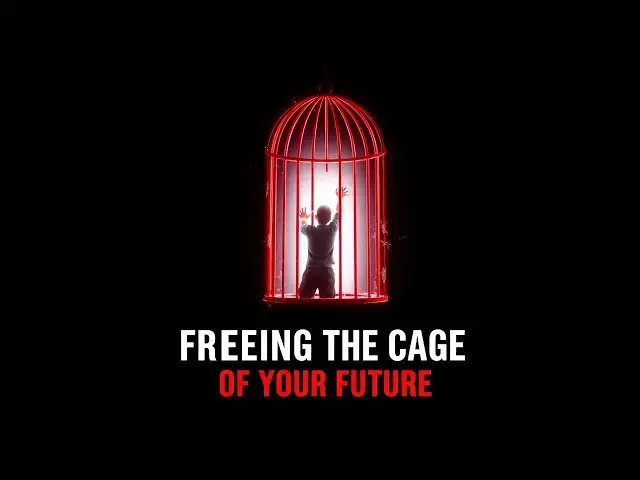0:00
Today we're breaking down a piece of
0:01
content with a title that is well pretty
0:04
much impossible to ignore. Comfort, the
0:07
cage of your future. It's a really
0:09
powerful idea and it's designed
0:11
specifically to make you look at your
0:12
own daily habits in a new light. So,
0:15
let's dive in and see exactly how it
0:17
makes its case. So, it all starts with
0:20
something so simple, something we can
0:24
all agree on, right? It's the perfect
0:26
hook. We all know that feeling. You
0:28
know, that sense of just ease after a
0:32
long day. It's a universal feeling. And
0:36
it's that exact feeling that this whole
0:38
philosophy is about to flip completely
0:41
upside down. And boom, there it is. Just
0:44
like that, the feeling you love is
0:46
reframed. This is the core conflict
0:48
they're setting up. The idea that the
0:50
thing that feels good in the moment is
0:52
actually trapping your future self. It's
0:55
a really bold, really confrontational
0:57
way to start. Okay, part one, the case
1:00
against comfort. So, how do they
1:03
actually frame a good feeling as a
1:05
dangerous habit? How does that argument
1:07
even work? Well, it starts by redefining
1:10
comfort as something that isn't just
1:13
passive, but is actively working against
1:15
you. Now, listen to the language they
1:17
use here. This is so important. Comfort
1:20
isn't just, you know, a state of
1:22
physical ease. No, they call it a drug.
1:26
a drug they feed you to keep you from
1:28
chasing freedom. That word choice is so
1:31
intentional. It implies you're being
1:33
numbed, pacified, and held back from
1:36
something bigger. And to make sure this
1:38
isn't just some abstract idea, they get
1:41
really specific with these everyday
1:43
examples. And look how they frame them.
1:46
Each one is a deposit into your own
1:48
failure. I mean, that's heavy. The
1:51
language is specifically designed to
1:53
make you stop and reync these super
1:55
common habits. So, hitting the snooze
1:58
button, it's not just 10 more minutes of
2:00
sleep in this world view. It's an active
2:03
investment in your own downfall. Next
2:05
up, a tale of two paths. Here's where
2:08
the source gives you two opposing
2:10
choices, each with its own outcome. So,
2:13
after they've defined the problem, they
2:15
present the solution as this really
2:17
dramatic choice. It's a classic
2:19
storytelling tool, right? Forcing you to
2:21
pick a side. And the contrast here could
2:24
not be more stark. It's totally
2:26
intentional. The easy path is all about
2:29
passive stuff, consuming things. The
2:32
hard path is all about active effort,
2:35
about exertion. By setting it up like
2:38
this, there's absolutely no middle
2:40
ground. You have to make a choice. And
2:42
this brings us to where each path leads.
2:45
The language is incredibly blunt.
2:48
Comfort doesn't just hold you back, it
2:50
buries you. And on the flip side,
2:52
discomfort doesn't just make you better,
2:55
it builds you. The whole point is to
2:58
connect your tiny daily actions to one
3:00
of these two massive lifealtering fates.
3:04
All right, next section, the demand for
3:06
action. Because, you know, understanding
3:08
the message is one thing, but it's just
3:11
as important to understand how that
3:13
message is actually designed to make you
3:15
do something. So, let's pull back the
3:17
curtain and analyze the persuasion
3:19
strategy they're using here. And this is
3:21
the key. You have to realize this
3:23
content is not neutral. It has a very
3:26
clear goal. And that goal is to make you
3:28
act. Every single word, every image,
3:31
it's all chosen to create a sense of
3:34
urgency and to provoke a real reaction
3:36
from you. You can actually break down
3:38
their whole strategy into a classic
3:40
persuasion funnel. It's a pretty clear
3:42
playbook. Step one, state a huge
3:46
dramatic problem. Comfort is killing
3:48
your future. Step two, offer the direct
3:51
opposite as the solution. Discomfort
3:54
builds you. Step three, give a direct
3:57
command. Choose. And finally, step four,
4:01
funnel that decision into a real
4:03
tangible action like sending a DM or
4:06
clicking a link. It's a straight line
4:08
from getting you to think to getting you
4:10
to click. And all of this brings us to
4:12
the end. The ultimate question. This is
4:16
the big choice, the core dilemma that
4:18
the source wants to leave rattling
4:19
around in your head long after you're
4:21
done watching. So after all the
4:24
arguments, all the metaphors, the entire
4:27
philosophy gets boiled down into just
4:29
four simple, powerful, and very
4:32
memorable words. This one statement is
4:34
meant to be the big takeaway. Comfort
4:37
isn't just rest. It's a prison. And it's
4:40
one you build for yourself. And that
4:43
that is exactly where the source
4:44
material leaves us with a choice. It
4:48
takes its own command, choose, and turns
4:50
it back on you as a direct question. By
4:53
framing comfort not as a feeling, but as
4:56
a cage, it forces you to look at your
4:59
own daily life and asks you point blank,
5:02
knowing this, what are you going to
5:04
choose? It's a question that is
5:06
absolutely designed to stick with you.


